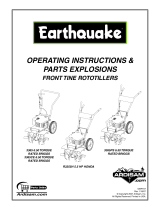
TWO YEAR
LIMITED WARRANTY
The Ardisam, Inc., Manufacturing Company warrants this
rototiller to be free from defects in material or workmanship.
Conditions of this warranty include:
What is covered under warranty:
For the first year from the date of purchase, Ardisam will
furnish 100% parts and labor to correct any defect caused
by faulty material or workmanship. During the second year
of ownership, Ardisam will furnish 100% of the parts to
correct any defect caused by faulty material or
workmanship. All repairs made under warranty must have
prior approval from Ardisam, Inc. Items subject to normal
wear and tear, such as belts, batteries, tines, shear bolts
and tires, due to the nature of their function are not
covered under this warranty. Any unit used in a
commercial application is covered for a period of 90
days after purchase. The engine is covered under a
separate warranty issued by the engine manufacturer
as stated in the engine manual.
What is not covered under warranty
.
This warranty applies only to products which have not been
repaired or altered outside our factory. It covers only
defects resulting from normal use, and does not cover
defects arising from misuse, alteration, negligence, or
accident. This warranty applies only to the original
purchaser, and is not transferrable.
This warranty supersedes all other warranties either
expressed or implied and all other obligations or
liabilities on our part Ardisam, Inc., does not assume,
and does not authorize any other person to assume for
us, any liability in connection with the sale of our
products. This guarantee is void unless the warranty
card is properly filled out and returned to Ardisam, Inc.,
Cumberland, Wisconsin, within two weeks of the
purchase date.
ARDISAM, INC.
ROWER GYRED,* 1ST SHELTERS * EDIOGIIERS
TREE STANDS * EMMEN SIMMERS * EDGERS
1360 1st Avenue; P.O. Sox 666
Cumberland, Wisconsin 54829
(715)822-2415 Fax
(715)822-4180
1-800-3456-007
sine attliaam.tom
WARRANTY AND REGISTRATION
Thank You . . .
for purchasing an Ardisam, Inc. CRT rototiller. We guarantee that this rototiller conforms to applicable North
American safety standards, and have worked to ensure that it will meet your exacting standards for usability
and durability. With proper care, your rototiller will provide many years of service.
Please take time to read this manual carefully to learn how to operate and service your rototiller
correctly Failure to do so could result in personal injury or equipment damage. This manual should be
considered a permanent part of your rototiller. Congratulations on your investment in quality
A
CAUTION
You must read, understand and comply with all safety
and operating instructions in this manual before
attempting to setup and operate this equipment.
Failure to comply with all safety and operating
instructions can result in loss of machine control,
serious personal injury to you and/or bystanders, and
risk of equipment and property damage. The triangle
in the text signifies important cautions or warnings
which must be followed.
A
CAUTION
Engine exhaust from this product contains chemicals
known, in certain quantities, to cause cancer, birth
defects, or other reproductive harm.
For easy reference, please record the
information on the chart below.
The Rototiller Reference Data can be found on the
identification tag located on the unit's left engine mount.
(Refer to the engine manual for location of engine
information and serial number.)
ROTOTILLER REFERENCE DATA
Model Description/Number
M/N (Manufacturers Number)
S/N (Serial Number)
Dealer Name
Date Purchased
4ENGINE
REFERENCE 0AT
Engine Make/Model
Engine ID/Serial Number
2























